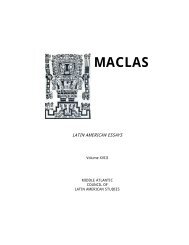latin american essays maclas
latin american essays maclas
latin american essays maclas
You also want an ePaper? Increase the reach of your titles
YUMPU automatically turns print PDFs into web optimized ePapers that Google loves.
ullfights to Easter services. According to Janine Montupet and Thislaine<br />
Schoeller (1990:123),<br />
The mantilla, the large scarf worn by Spanish women, was sacred,<br />
forming part of the woman and of her dignity. It could not be<br />
confiscated in the case of debt, in spite of its considerable value,<br />
whether it was made of blonde [named for the original thread material<br />
but made in many colors, especial black], Chantilly, or needle lace. Of<br />
course, that sacred quality lay not in the lace itself, even if it had been<br />
divinely made, but in its use as a head covering for women when they<br />
entered the house of God.<br />
The hallmark of Spanish embroidery was intricate patterning executed in<br />
simple stitches and limited coloring. The background fabric was usually plain<br />
linen thread or of aloe fiber. There is little evidence for a strong lace tradition in<br />
Spain and much of the fine lace was imported. However, Cervantes referred to a<br />
domestic variety of lace in The Visionary Gentleman (1615). Sol or rueda lace<br />
developed in the period of 1560 to 1620 in Spain and it remained specific to<br />
Spain and its colonies. It was used to make a number of items, from men’s<br />
shirts to altar vestments (Levey 1983:29). Santina M. Levey (1983: plates 180-<br />
182) provides photographs of three historic examples from the Victoria & Albert<br />
Museum in London and the Musée Historique des Tissus in Lyons.<br />
Tenerife lace was especially popular in the sixteenth and seventeenth<br />
centuries. According to Kathleen Warnick and Shirley Nilsson (1988:117), the<br />
Spanish brought this textile technique to the New World. The distinctive features<br />
of this type of Tenerife lace is that there is a circular spoke of crossed threads at<br />
the center of the motif, the designs are woven into the spoke using a needle, the<br />
spoke threads are held in position with knot stitches, and smaller motifs are<br />
joined to make larger pieces (1988:118). The Tenerife technique uses pattern<br />
cards with pins stuck into the edges in order to wrap thread in making the<br />
grounding wheel-spoke pattern. This is an easier technique for making a spoke<br />
ground, which results in a less delicate lace. It has been copied in various forms<br />
of textile production such as macramé and knitting, which have since spread<br />
throughout the world (Levey 1983:115).<br />
Although most of the references available for the history of ñandutí<br />
production suggest that Paraguay’s lace tradition arrived from Tenerife, this is<br />
not the case. Both ñandutí and Tenerife lace have their own distinct histories.<br />
In Paraguay, the technique remained similar to the original delicate form but<br />
eventually developed its own patterns and renamed some of the tradition<br />
patterns, giving them local names in both Guaraní and Spanish.<br />
In Paraguay, thread originally was made by hand and of natural fiber;<br />
therefore, it was white or ivory. All of the early ñandutí for which we still have<br />
samples or photos are made of white or ivory thread. In modern Paraguay, the<br />
3




